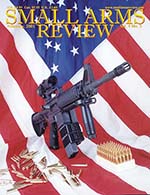SAAB Bofors Dynamic's CBJ MS PDW
By Charles Q. Cutshaw
Personal Defense Weapons (PDWs) are a current small arms “hot ticket,” especially with the British Ministry of Defence’ recent solicitation that could result in the purchase of some 15,000 PDWs. Although several small arms manufacturers have submitted samples for the competition, one of the more interesting ones was recently shown at the National Defense Industrial Association’s annual Small Arms Conference in Indianapolis, Indiana. Saab and Bofors are both well - known in the defense industry, but not in the small arms field. In this case, however, the two firms have joined forces to produce a dual - caliber PDW for the British competition and for other military and police organizations seeking PDWs.
The CBJ MS is chambered for the traditional 9x19mm pistol cartridge, but by changing barrels can also fire the new 6.5x25mm CBJ cartridge. The 6.5x25mm cartridge is dimensionally identical to the 9x19mm, so the little CBJ MS PDW can use the same magazines and bolt, as cartridge head diameter is also the same with both cartridges. The 6.5x25mm cartridge was developed specifically to meet the NATO CRISAT body armor defeat criteria and according to Bofors representatives, does so to a range of 400 meters. The round also defeats light vehicle bodies. The round itself consists of a 25mm bottlenecked cartridge case and a bullet with a small 4mm diameter saboted tungsten carbide penetrator weighing 2 grams. The penetrator is carried in a plastic sabot that peels away shortly after the projectile leaves the muzzle of the PDW. Performance data regarding this cartridge can be found at Table 2. The ballistic data are extrapolated from manufacturer’s information via a ballistic computer model that has proven to closely real world external ballistic performance. Although the 6.5 CBJ cartridge is claimed to be effective to a distance of 400 meters, realistic engagement distances for PDWs are less than 100 meters; hence our data use that as a maximum.
The CBJ PDW itself is of fairly conventional design, resembling several existing submachine guns in overall design and configuration, but with several innovative features. Operation is blowback, but with two options - either open bolt firing with fixed firing pin or closed bolt firing with floating firing pin. The latter option should prove to be more accurate and possibly more reliable, but only extended testing will establish the overall performance levels of the CBJ MS. The CBJ MS is equipped with a titanium suppressor as standard for use with 9mm ammunition. The CBJ MS also has an optional grenade launcher and Bofors is developing fin stabilized rifle grenades for the weapon. The grenades are launched using standard 9mm or 6.5mm cartridges and include HE, HEAT, smoke, tear gas or flash/bang types. Magazines of 20, 30 and 100 rounds capacity are available. The latter magazine is a drum type that is only slightly longer than the standard 30 round magazine. Bofors provides both types of ammunition in clips of 30 rounds for rapid magazine reloading. The CBJ MS feeds via a magazine inserted in the pistol grip with a spare magazine carried in the forward pistol grip. This provides for quick magazine changes in fast-moving combat situations. The forward pistol grip incorporates a curved guard to prevent the “off” hand from overriding the grip and covering the muzzle of the weapon. A MIL-STD-1913 rail is fixed to the top of the receiver for mounting optics. The standard CBJ MS optical sight is the Trijicon 1.5x24. Open sights are a post type front sight with tritium insert, adjustable for elevation and a three position rear sight that is adjustable for windage. According to the manufacturer, the CBJ MS can also be used as a light support weapon (LSW) and to that end, a bipod is provided as standard. We believe that use of such a weapon as an LSW is somewhat ambitious, given the ballistics of the ammunition and inherent accuracy constraints of weapons of this nature. Again, only extended testing will confirm or deny the manufacturers’ claims in this regard. The CBJ MS also is provided with a small bag that attaches to the receiver to catch spent cartridge casings, a highly unusual accessory in a tactical firearm. “Brass bags” are usually associated with training environments where expended casings must be gathered before leaving the range. In this instance, however, the manufacturer emphasizes the capability of the bag to be quickly emptied in action.
It is impossible to accurately assess a firearm without actually firing it and SAAB Bofors unfortunately did not have any fully functional examples of their new PDW at the NDIA Small Arms Conference. Extensive “hands-on” examination of the CBJ MS while at the SAAB Bofors display booth, however, gave a favorable first impression of this latest PDW. Controls are well - placed and their use is obvious after a quick cursory examination of the weapon. We were able to operate the bolt, selector, magazine release and extend and retract the stock without coaching from SAAB Bofors representatives. The little PDW balances and points well, but only time and actually testing the CBJ MS on the range will tell if these general first impressions carry over into actual functional usage of the SAAB Bofors CBJ MS.
This article first appeared in Small Arms Review V4N5 (February 2001) |
| SUBSCRIBER COMMENT AREA |
Comments have not been generated for this article.





